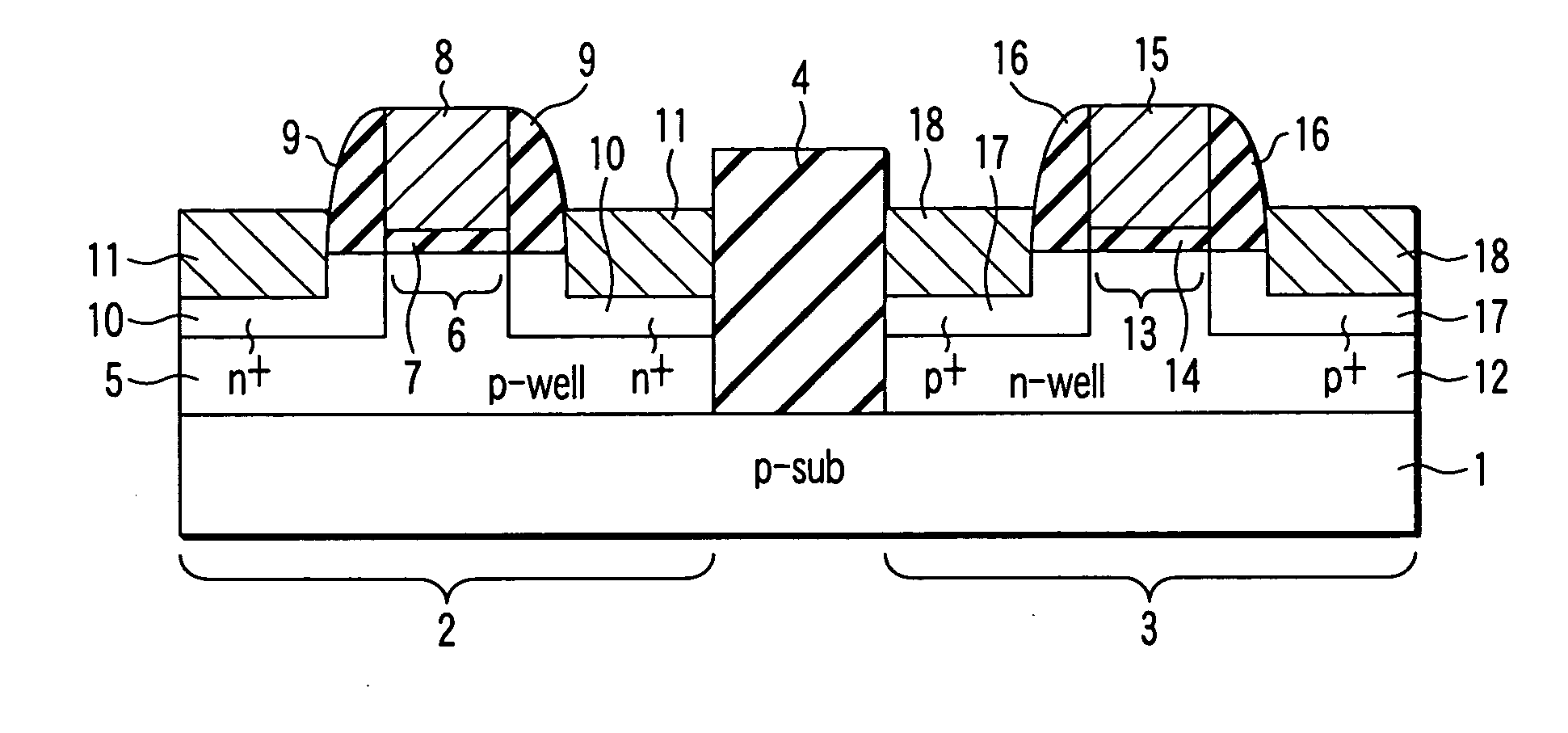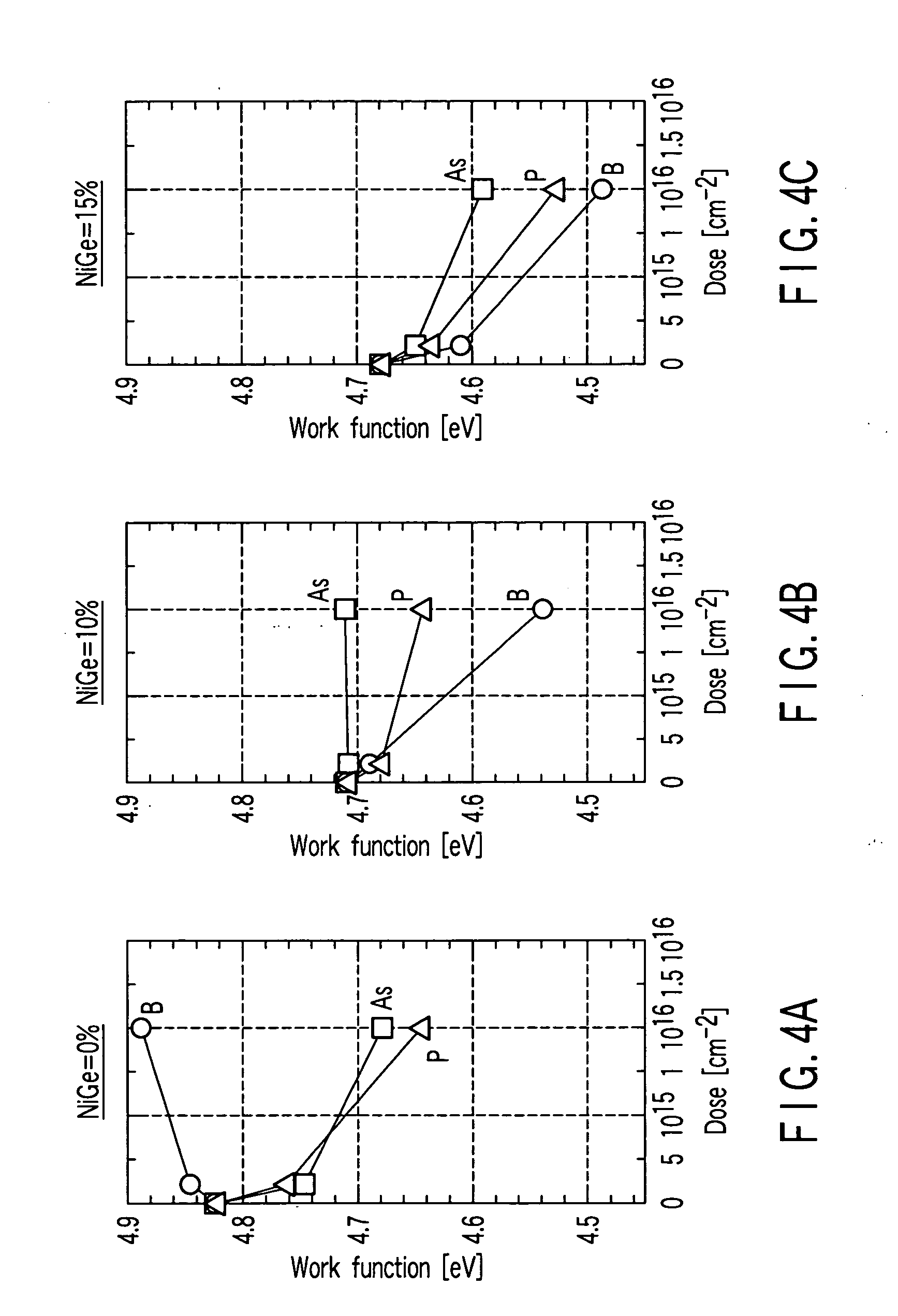Semiconductor device
- Summary
- Abstract
- Description
- Claims
- Application Information
AI Technical Summary
Problems solved by technology
Method used
Image
Examples
first embodiment
[0059] (First Embodiment)
[0060] A CMISFET according to the first embodiment will be described below with reference to FIG. 1. As shown in FIG. 1, an n-MISFET 2 and a p-MISFET 3 are formed on a p-type silicon substrate 1 in a state of being isolated from an isolation region 4.
[0061] First, the n-MISFET 2 will be explained below. A p-well 5 (p-type impurity region) is formed on the p-type silicon substrate 1. The center of the upper portion of the p-well 5 is formed with an n-channel region 6. The n-channel region calls a region formed with an n-channel when gate voltage is applied. A first gate insulator 7 is formed on the n-channel region 6, and a first gate electrode 8 is formed on the first gate insulator 7. The first gate electrode 8 is interposed between first gate sidewall insulators 9. A pair of n-type source / drain regions 10 (n-type highly-doped impurity region) is formed on the opposite position via the n-channel region 6 on the p-well 5. The upper portion of the n-type sou...
second embodiment
[0089] (Second Embodiment)
[0090] A CMISFET according to the second embodiment will be described below in the point different from the first embodiment. The CMISFET of the second embodiment is based on the same technical concept as the CMiSFET of the first embodiment. However, the second embodiment differs from the first embodiment in that C is doped to the gate electrode. Therefore, the CMISFET of the second embodiment has the same cross-sectional structure as the first embodiment. Thus, the CMISFET of the second embodiment will be described below with reference to FIG. 1.
[0091] A compound M(SiGeC) of metal element M and group IV semiconductor element SiGeC is used as the material of the first and second gate electrodes 8 and 15. In the composition, group IV semiconductor elements, that is, Ge and C are solid-soluble in at least one gate electrode. More specifically, the material of the first gate electrode 8 is M(Si1−a−b GeaCb) (0≦a≦1, 0≦b≦0.02, 0≦a+b≦1). The material of the secon...
third embodiment
[0098] (Third Embodiment)
[0099] A CMISFET according to the third embodiment will be described in the point different from the first embodiment. The CMISFET according to the third embodiment has features given below. More specifically, several metal elements are used as M of the gate electrode material M(SiGe) of the CMISFET according to the first embodiment, and the M(SiGe) has the same crystal structure. Therefore, the CMISFET of the third embodiment has the same cross-sectional structure as the first embodiment. Thus, the CMISFET of the third embodiment will be described below with reference to FIG. 1.
[0100] A compound M(SiGe) of metal element M and group IV semiconductor element is used as the material of the first and second gate electrodes 8 and 15, like the first embodiment. In this case, M is two or more metal elements selected from Ni, Pd and Pt, or Ti and Zr.
[0101] The following is an explanation about Ni, Pd and Pt. According to the third embodiment, the foregoing mixed ...
PUM
 Login to View More
Login to View More Abstract
Description
Claims
Application Information
 Login to View More
Login to View More - R&D
- Intellectual Property
- Life Sciences
- Materials
- Tech Scout
- Unparalleled Data Quality
- Higher Quality Content
- 60% Fewer Hallucinations
Browse by: Latest US Patents, China's latest patents, Technical Efficacy Thesaurus, Application Domain, Technology Topic, Popular Technical Reports.
© 2025 PatSnap. All rights reserved.Legal|Privacy policy|Modern Slavery Act Transparency Statement|Sitemap|About US| Contact US: help@patsnap.com



